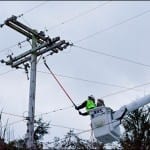 The Northwest is famous for microclimate conditions.
The Northwest is famous for microclimate conditions.
Storm fronts materialize out of nowhere, like the wind gusts that buffeted the region on Sunday afternoon, taking out power in at least five counties.
From Bellevue to Bainbridge Island, this reporter’s public utility, Puget Sound Energy, attributed the outages to many things via recorded message “updates,” from “a small animal” to “tree vegetation.”
The question arises: Are these kind of weather disturbances something new? Or is this Northwest weather as usual?
One thing that it is not is business as usual. We’re referring to the way different public utilities respond to power outages and restorations, the average response times, and the roles that subcontractors play. The new model among some utilities is to outsource the maintenance and repair of power lines to personnel outside of their direct control.
Those of us in the tech and online industries know a little something about the concept of uptime performance that apparently the utility companies do not. It is not the event that triggers a disruption, or the precipitating factor that knocks a system offline that is at issue. The reliability standard is the amount of “downtime” that is imposed upon the tens, if not hundreds of thousands of vulnerable energy users as a result of a power outage and the mean time between failure and restoration. That is the truest measure of performance.
Top-tier Internet service providers, Web hosting companies, Web servers like Amazon AWS and SaaS vendors all measure their overall success or failure as a percentage of “uptime,” typically claiming rates higher than 95% with many at 99 percent and a fraction. Adverse conditions will continue, that fact is a given. It is how quickly the uptime can be restored that is the essential question.
When a public utility like PSE takes no preventative measures to guard against downed power lines, such as burying energy lines underground, it should be held accountable to an uptime standard. If it cannot respond in a timeframe that achieves a satisfactory uptime record it should be subject to honoring claims for spoiled food, loss of business, material damage claims suffered by its customers. and other sanctions. Without such a regulatory uptime standard these utilities are not serving the public’s welfare at all. Rather, they are free to fall back on the corporate imperative of weighing the speed and cost of restoration against the profit, loss and shareholder value in the equation, something quite outside the public interest.
 A case in point was the recent wind storm that blew across the Puget Sound at around 2pm Sunday afternoon. Once “tree vegetation” caused power to be interrupted for tens of thousands in scattered Northwest communities, reports of power outages flooded the phone lines. In our case, Puget Sound Energy announced that restoration could be expected by 8pm the very same evening, six hours later. The problem is that such an estimate strained any measure of credulity. Why?
A case in point was the recent wind storm that blew across the Puget Sound at around 2pm Sunday afternoon. Once “tree vegetation” caused power to be interrupted for tens of thousands in scattered Northwest communities, reports of power outages flooded the phone lines. In our case, Puget Sound Energy announced that restoration could be expected by 8pm the very same evening, six hours later. The problem is that such an estimate strained any measure of credulity. Why?
PSE outsources its tree and branch removal service to Asplundh and the Asplundh crews were unable to be summoned until the following day, a Monday. Meanwhile the PSE restoration estimates ratcheted upward from 8pm to 2am to 8:30 am the next morning. Let’s call this charade “PSE Restoration Theater.” How is it the power company could claim restoration six hours, or 12 hours before subcontracted work crews could even arrive on the scene, and 18 hours before power was finally restored.Yep, it took nearly 24 hours to restore a downed line caused by Northwest “tree vegetation” propelled by wind.
How about PSE telling consumers what it would cost US to bury the power lines. Then we could calculate what a day of OUR time is worth to our stakeholders.
What’s worse is that the PSE data services backbone, upgraded in April, was reportedly inoperative during the entire storm period and its immediate aftermath, this according to Puget Sound Energy employees interviewed by Seattle24x7. So the crews could not be matched with outages in any event.
Let’s be honest. High winds and weather disturbances are a reality, not an exception, in our gusty neck of the woods. The measure of a public utility, like Puget Sound Energy, rests on how well it can mobilize against outages and mitigate downtime and losses in the face of such disruptions. Since utilities cannot predict the disturbances, it is up to them to show resourceful and resilient responsiveness in remedying problems as they happen, in terms of real response time. Yes, let’s keep it real!
If public utilities cannot perform to these standards, then the public should be given every right to demand just compensation for any losses. [24×7]




















